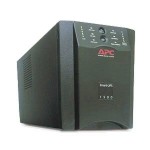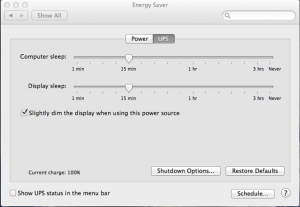 Fluctuating or unclean power is one of the things that cause electronics most problems. Fortunately uninterruptible power supplies, UPS’s, are readily available and relatively inexpensive. A UPS plugs in to the electric current coming from your house and provides additional outlets. These devices condition the power coming from the electric outlet before it gets to your computer so that spikes and fluctuations are mitigated. If that sounds similar to a surge suppressor, it’s because it UPS will replace your surge suppressor. It provides the same functions but it also provides one great additional benefit. An uninterruptible power supply provides battery backup for the electrical power coming from your outlook.
Fluctuating or unclean power is one of the things that cause electronics most problems. Fortunately uninterruptible power supplies, UPS’s, are readily available and relatively inexpensive. A UPS plugs in to the electric current coming from your house and provides additional outlets. These devices condition the power coming from the electric outlet before it gets to your computer so that spikes and fluctuations are mitigated. If that sounds similar to a surge suppressor, it’s because it UPS will replace your surge suppressor. It provides the same functions but it also provides one great additional benefit. An uninterruptible power supply provides battery backup for the electrical power coming from your outlook.
UPS’s are made with a battery internal to the unit. All electrical power goes from the outlet in your house to the battery and charges the battery. The battery then supplies power directly to anything plugged in to the device. If there are spikes, fluctuations or brown outs in the electricity coming from the power company the battery takes over and keeps those from affecting your electronic devices. If the power coming to your home goes out completely, the battery takes over powering the devices for a certain amount of time depending upon the size of the battery that’s included in the UPS. This function is all well and good, but on a Macintosh, the UPS has the ability to connect to the computer and intelligently give the computer commands telling it that the power is out. There are similar functions in windows but these often require additional software installed that comes with the UPS.
 In recent versions of the Macintosh operating system, Apple has included support for UPS devices built-in. This support is controlled in the energy saver system preference panel. Without a UPS connected, you cannot see the controls. Once you plug in a UPS with a USB cable thats usually included with the device, new and additional options are provided in the same energy saver panel. It is important to note that this USB cable typically needs to be plugged directly into the computer and not through a USB hub.
In recent versions of the Macintosh operating system, Apple has included support for UPS devices built-in. This support is controlled in the energy saver system preference panel. Without a UPS connected, you cannot see the controls. Once you plug in a UPS with a USB cable thats usually included with the device, new and additional options are provided in the same energy saver panel. It is important to note that this USB cable typically needs to be plugged directly into the computer and not through a USB hub.
With the UPS connected, looking at the energy saver panel you have the ability to turn on an icon in the menu bar that allows you to check the charging status of the battery in the UPS. You also have the ability to set shutdown options that tell the computer how to correctly shut down based upon the power being given from the battery in the UPS device. Typically, you would want to turn on the option that allows the computer to be shut down when the UPS power reaches something near 25%.
This setting will allow your computer to get through all brown outs and power fluctuations  without being affected. It will also continue to power the computer for a period of time after the power goes out. In this way you’re able to not have to force the computer to shut down if the power outage is short. If the power outage continues for a period of time that causes the battery power to reduce down by 75%, the computer will begin the shutdown process. The final 25% of the power in the UPS will get the computer shutdown correctly. This way, the hard drive on your computer doesn’t abruptly shut down with the possibility of file loss.
without being affected. It will also continue to power the computer for a period of time after the power goes out. In this way you’re able to not have to force the computer to shut down if the power outage is short. If the power outage continues for a period of time that causes the battery power to reduce down by 75%, the computer will begin the shutdown process. The final 25% of the power in the UPS will get the computer shutdown correctly. This way, the hard drive on your computer doesn’t abruptly shut down with the possibility of file loss.
There are a number of UPS devices on the market, but the major player in this field is APC. Uninterruptible power supplies from APC are recognized directly by the Mac and allow this built in software in your operating system to control the UPS.
If you live in a location where the power is not stable, or have reasons that the power fluctuates, a UPS may be just the thing to protect your computer.
